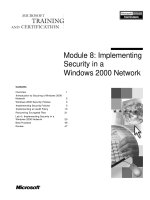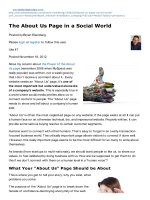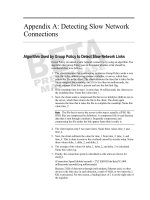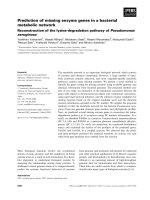Living in a Network-Centric World Network Fundamentals pptx
Bạn đang xem bản rút gọn của tài liệu. Xem và tải ngay bản đầy đủ của tài liệu tại đây (18.46 MB, 560 trang )
© 2006 Cisco Systems, Inc. All rights reserved. Cisco PublicITE I Chapter 6
1
Living in a Network-Centric World
Network Fundamentals – Chapter 1
Simpo PDF Merge and Split Unregistered Version -
© 2006 Cisco Systems, Inc. All rights reserved. Cisco PublicITE 1 Chapter 6
2
Objectives
In this chapter, you will learn to:
– Describe how networks impact our daily lives.
– Describe the role of data networking in the human network.
– Identify the key components of any data network.
– Identify the opportunities and challenges posed by
converged networks.
– Describe the characteristics of network architectures: fault
tolerance, scalability, quality of service and security.
– Install and use IRC clients and a Wiki server.
Simpo PDF Merge and Split Unregistered Version -
© 2006 Cisco Systems, Inc. All rights reserved. Cisco PublicITE 1 Chapter 6
3
Networks supporting the way we live
Among all of the essentials for human existence, the
need to interact with others ranks just below our need
to sustain life.
–Communication is almost as important to us as our
reliance on air, water, food, and shelter.
The methods that we use to share ideas and
information are constantly changing and evolving.
–Whereas the human network was once limited to face-
to-face conversations.
–Early data networks were limited to exchanging
character-based information between connected
computer systems.
–Current networks have evolved to carry voice, video
streams, text, and graphics between many different
types of devices.
Simpo PDF Merge and Split Unregistered Version -
© 2006 Cisco Systems, Inc. All rights reserved. Cisco PublicITE 1 Chapter 6
4
The Global Community
Technology is perhaps the most
significant change agent in the world
today, as it helps to create a world in
which national borders, geographic
distances, and physical limitations
become less relevant, and present ever-
diminishing obstacles.
–The creation of online communities for the
exchange of ideas and information has the
potential to increase productivity
opportunities across the globe.
–As the Internet connects people and
promotes unfettered communication, it
presents the platform on which to run
businesses, to address emergencies, to
inform individuals, and to support education,
science, and government.
Simpo PDF Merge and Split Unregistered Version -
© 2006 Cisco Systems, Inc. All rights reserved. Cisco PublicITE 1 Chapter 6
5
The way we live is supported by services derived by the data network
It is incredible how quickly the Internet became an integral
part of our daily routines.
In the course of a day, resources available through the
Internet can help you:
–Decide what to wear using online current weather conditions.
–Find the least congested route to your destination, displaying
weather and traffic video from webcams.
–Check your bank balance and pay bills electronically.
–Receive and send e-mail, or make an Internet phone call, at an
Internet cafe over lunch.
–Obtain health information and nutritional advice from experts all
over the world, and post to a forum to share related health or
treatment information.
–Download new recipes and cooking techniques to create a
spectacular dinner.
–Post and share your photographs, home videos, and
experiences with friends or with the world.
Simpo PDF Merge and Split Unregistered Version -
© 2006 Cisco Systems, Inc. All rights reserved. Cisco PublicITE 1 Chapter 6
6
Popular Communication Tools
Instant Messaging
–Instant messaging (IM) is a form of real-time communication
between two or more people based on typed text.
•The text is conveyed via computers connected over either a private
internal network or over a public network, such as the Internet.
Weblogs (blogs)
–Weblogs are web pages that are easy to update and edit.
•Weblogs give anyone a means to communicate their thoughts to a
global audience without technical knowledge of web design.
Wikis
–Wikis are web pages that groups of people can edit and view
together. Whereas a blog is more of an personal journal.
•There is a public wiki, called Wikipedia, that is becoming a
comprehensive online encyclopedia.
•Private organizations and individuals can also build their own wikis to
capture collected knowledge on a particular subject.
Podcasting
–Podcasting is an audio-based medium that originally enabled
people to record audio and convert it for use with iPods.
•The audio file is placed on a website where others can download it and
play the recording on their computers, laptops, and iPods.
Collaboration Tools
–Collaboration tools give people the opportunity to work together
on shared documents. Without the constraints of location or time
zone, individuals connected to a shared system can speak to each
other, share text and graphics, and edit documents together.
•The broad of data networks means that people in remote locations can
contribute on an equal basis with people at the large population centers.
Simpo PDF Merge and Split Unregistered Version -
© 2006 Cisco Systems, Inc. All rights reserved. Cisco PublicITE 1 Chapter 6
7
Networks Supporting the way we learn
Courses delivered using network or Internet
resources are often called online learning
experiences, or e-learning.
1. Traditional learning methods: Provide primarily two
sources of expertise: the textbook and the instructor.
•These two sources are limited, both in the format and the
timing of the presentation.
2. Online courses: Contain voice, data, and video, and
are available to the students at any time from any place.
•Students can follow links to different references and to
subject experts in order to enhance their learning
experience.
•Online discussion groups and message boards enable a
student to collaborate with the instructor, with other students
in the class, or even with students across the world.
3. Blended courses can combine instructor-led classes with
online courseware to provide the best of both delivery methods.
•Access to high quality instruction is no longer restricted to
students living in proximity to where that instruction is being
delivered.
•Online distance learning has removed geographic barriers
and improved student opportunity.
Simpo PDF Merge and Split Unregistered Version -
© 2006 Cisco Systems, Inc. All rights reserved. Cisco PublicITE 1 Chapter 6
8
Networks Supporting the way we learn
The Cisco Networking Academy Program,
is an example of a global online learning
experience.
–The instructor provides a syllabus and
establishes a preliminary schedule for
completing the course content.
–The Academy program provides text,
graphics, animations, and a simulated
networking environment tool called Packet
Tracer.
•Packet Tracer provides a way to build virtual
representations of networks and emulate many
of the functions of networking devices.
–Students may communicate with the
instructor and fellow students using online
tools, like e-mail, bulletin/discussion boards,
chat rooms, and instant messaging.
Simpo PDF Merge and Split Unregistered Version -
© 2006 Cisco Systems, Inc. All rights reserved. Cisco PublicITE 1 Chapter 6
9
Networks Supporting the way we learn
In the business world, the use of networks to provide
efficient and cost-effective employee training is
increasing in acceptance.
–Online learning opportunities can decrease time-
consuming and costly travel yet still ensure that all
employees are adequately trained to perform their jobs.
The benefits of online courseware are:
–Current and accurate training materials.
•Courseware is up-to-date. When errors in materials are
found and corrected, the new courseware is immediately
available to all employees.
–Availability of training to a wide audience.
•Employees can be given deadlines by which training is to
be completed and the employees can access the
courseware when it is convenient.
–Consistent quality of instruction.
•The quality of the instruction does not vary. The online
curriculum provides a consistent core of instruction to which
instructors can add additional expertise.
–Cost reduction.
•In addition to reducing the cost of travel and the lost time
associated with travel, there are other cost reducing factors
for business related to online training. It is usually less
expensive to revise and update online courseware than it is
to update paper-based material.
Simpo PDF Merge and Split Unregistered Version -
© 2006 Cisco Systems, Inc. All rights reserved. Cisco PublicITE 1 Chapter 6
10
Networks Supporting the way we work
Initially, data networks were used by businesses
to internally record and manage financial
information, customer information, and
employee payroll systems.
Today, networks provide a greater integration
between related functions and organizations
than was possible in the past.
–Intranets: private networks in use by just one
company, enable businesses to communicate and
perform transactions among global employee and
branch locations.
–extranets, or extended internetworks: to provide
suppliers, vendors, and customers limited access
to corporate data to check order status, inventory,
and parts lists.
Simpo PDF Merge and Split Unregistered Version -
© 2006 Cisco Systems, Inc. All rights reserved. Cisco PublicITE 1 Chapter 6
11
Networks Supporting the way we work
Consider these business scenarios.
–Remote workers, called teleworkers or
telecommuters, use secure remote access
services from home or while traveling.
•The data network enables them to work as if
they were on-site, with access to all the
network-based tools normally available for
their jobs.
–Virtual meetings and conferences can be
convened which include people in remote
locations.
•The network provides audio and video
capability so all participants can both see and
hear each other.
•The information from the meetings can be recorded
to a wiki or blog. The latest versions of the agenda
and minutes can be shared as soon as they are
created.
Simpo PDF Merge and Split Unregistered Version -
© 2006 Cisco Systems, Inc. All rights reserved. Cisco PublicITE 1 Chapter 6
12
Networks Supporting the way we play
The widespread adoption of the Internet by the
entertainment and travel industries enhances the ability to
enjoy and share many forms of recreation, regardless of
location.
–It is possible to explore places interactively that previously we
could only dream of visiting, as well as preview the actual
destinations before making a trip.
The Internet is used for traditional forms of entertainment,
as well. We listen to recording artists, preview or view
motion pictures, read entire books and download material
for future offline access.
–Live sporting events and concerts can be experienced as they
are happening, or recorded and viewed on demand.
Networks enable the creation of new forms of entertainment,
such as online games.
–We compete with friends and foes around the world in the same
manner if they were in the same room.
Online markets and auction sites provide the opportunity to
buy, sell and trade all types of merchandise.
Whatever form of recreation we enjoy in the human network,
networks are improving our experience.
Simpo PDF Merge and Split Unregistered Version -
© 2006 Cisco Systems, Inc. All rights reserved. Cisco PublicITE 1 Chapter 6
13
What is communication?
Communication in our daily lives takes many forms and
occurs in many environments.
Establishing the Rules
Before beginning to communicate with each other, we
establish rules (protocols) or agreements to govern the
conversation. Among the protocols that govern successful
human communication are:
–An identified sender and receiver
–Agreed upon method of communicating (face-to-face,
telephone, letter, photograph)
–Common language and grammar
–Speed and timing of delivery
–Confirmation or acknowledgement requirements
The techniques that are used in network communications
share these fundamentals with human conversations.
–In establishing data networks, it is necessary to be much more
explicit about how communication takes place and how it is
judged successful.
Simpo PDF Merge and Split Unregistered Version -
© 2006 Cisco Systems, Inc. All rights reserved. Cisco PublicITE 1 Chapter 6
14
Quality of communications
Communication between individuals is determined to be
successful
–when the meaning of the message understood by the
recipient matches the meaning intended by the sender.
However, as a message moves through the network,
many factors can prevent the message from reaching the
recipient or distort its intended meaning. These factors
can be either external or internal.
–External Factors
•The quality of the pathway between the sender and the
recipient
•The number of times the message has to change form
•The number of times the message has to be redirected
or readdressed
•The number of other messages being transmitted
simultaneously on the communication network
•The amount of time allotted for successful
communication
Simpo PDF Merge and Split Unregistered Version -
© 2006 Cisco Systems, Inc. All rights reserved. Cisco PublicITE 1 Chapter 6
15
Quality of communications: Internal Factors
Internal Factors
–Internal factors that interfere with network communication
are related to the nature of the message itself.
Internal factors affecting the successful communication
across the network include:
–The size of the message
•Large messages may be interrupted or delayed at different
points within the network.
–The complexity of the message
–The importance of the message
•A message with a low importance or priority could be dropped
if the network becomes overloaded.
Both the internal and external factors that affect the
receipt of a message must be anticipated and controlled
for network communications to be successful.
–New innovations in network hardware and software are
being implemented to ensure the quality and reliability of
network communications.
Simpo PDF Merge and Split Unregistered Version -
© 2006 Cisco Systems, Inc. All rights reserved. Cisco PublicITE 1 Chapter 6
16
Quality of communications: Internal Factors
Demo: PING test
Simpo PDF Merge and Split Unregistered Version -
© 2006 Cisco Systems, Inc. All rights reserved. Cisco PublicITE 1 Chapter 6
17
Communicating over networks
In order to support the immediate delivery of the
millions of messages being exchanged between
people all over the world, we rely on a web of
interconnected networks. All networks have four
basic elements in common:
–Rules or agreements to govern how the messages are
sent, directed, received and interpreted
–The messages or units of information that travel from
one device to another
–A means of interconnecting these devices - a medium
that can transport the messages from one device to
another
–Devices on the network that exchange messages with
each other
The standardization of the various elements of the
network enables equipment and devices created by
different companies to work together.
–Experts in various technologies can contribute their
ideas on how to develop an efficient network, without
regard to the brand or manufacturer of the equipment.
Simpo PDF Merge and Split Unregistered Version -
© 2006 Cisco Systems, Inc. All rights reserved. Cisco PublicITE 1 Chapter 6
18
Elements of a network
The diagram shows elements of a
typical network, including
–devices,
–media,
–rules,
–messages.
•We use the word messages as a term that
encompasses web pages, e-mail, instant
messages, telephone calls, and other forms of
communication enabled by the Internet.
In this course, we will learn about a variety of
messages, devices, media, and services that
allow the communication of those messages.
–We will also learn about the rules, or protocols,
that tie these network elements together.
Simpo PDF Merge and Split Unregistered Version -
© 2006 Cisco Systems, Inc. All rights reserved. Cisco PublicITE 1 Chapter 6
19
Elements of a network
Icons are commonly used to represent networking devices.
On the left side of the diagram are shown some common
devices which often originate messages that comprise our
communication.
–These include various types of computers (a PC and laptop
icon are shown), servers, and IP phones. On local area networks
these devices are typically connected by LAN media (wired or
wireless).
The right side of the figure shows some of the most
common intermediate devices, used to direct and manage
messages across the network.
–Switch - the most common device for interconnecting local area
networks
–Firewall - provides security to networks
–Router - helps direct messages as they travel across a network
–Wireless Router - a specific type of router often found in home
networks
–Cloud - used to summarize a group of networking devices, the
details of which may be unimportant to the discussion at hand
–Serial Link - one form of WAN interconnection, represented by
the lightning bolt-shaped line
Simpo PDF Merge and Split Unregistered Version -
© 2006 Cisco Systems, Inc. All rights reserved. Cisco PublicITE 1 Chapter 6
20
Elements of a network
Network connections can be wired or wireless.
–In wired connections, the medium is either
copper, which carries electrical signals, or optical
fiber, which carries light signals.
•Copper medium includes cables, such as twisted
pair telephone wire, coaxial cable, or most
commonly, what is known as Category 5 Unshielded
Twisted Pair (UTP) cable.
•Optical fibers, thin strands of glass or plastic that
carry light signals, are another form of networking
media.
–In wireless connections, the medium is the
Earth's atmosphere, or space, and the signals are
microwaves.
•Wireless media may include the home wireless
connection between a wireless router and a
computer with a wireless network card, the terrestrial
wireless connection between two ground stations, or
the communication between devices on earth and
satellites.
Simpo PDF Merge and Split Unregistered Version -
© 2006 Cisco Systems, Inc. All rights reserved. Cisco PublicITE 1 Chapter 6
21
Elements of a network
/>Simpo PDF Merge and Split Unregistered Version -
© 2006 Cisco Systems, Inc. All rights reserved. Cisco PublicITE 1 Chapter 6
22
Elements of a network
Human beings often seek to send and receive a
variety of messages using computer applications;
these applications require services to be provided by
the network.
–World Wide Web, e-mail, instant messaging, and IP
Telephony.
Devices interconnected by medium to provide
services must be governed by rules, or protocols.
–Protocols are the rules that the networked devices use
to communicate with each other.
The industry standard in networking today is a set of
protocols called TCP/IP (Transmission Control
Protocol/Internet Protocol).
–TCP/IP is used in home and business networks, as well
as being the primary protocol of the Internet.
–It is TCP/IP protocols that specify the formatting,
addressing and routing mechanisms that ensure our
messages are delivered to the correct recipient.
OSCAR is AOL's flagship instant
messaging and presence information
protocol standing for Open System for
CommunicAtion in Realtime. Currently
OSCAR is in use for AOL's two main
instant messaging systems: ICQ and AIM.
Simpo PDF Merge and Split Unregistered Version -
© 2006 Cisco Systems, Inc. All rights reserved. Cisco PublicITE 1 Chapter 6
23
Elements of a network
We close this section with an example to tie together how the elements of networks –
message, devices, media, and services - are connected by rules to deliver a message.
The Messages
–In the first step, our instant message gets converted into a format that can be transmitted on the
network. All types of messages must be converted to bits, before being sent to their destinations.
The Devices
–When we think of using network services, we usually think of using a computer to access them.
But, a computer is only one type of device that can send and receive messages over a network.
•Among these devices are telephones, cameras, music systems, printers and game consoles.
Simpo PDF Merge and Split Unregistered Version -
© 2006 Cisco Systems, Inc. All rights reserved. Cisco PublicITE 1 Chapter 6
24
Elements of a network
The Medium
–To send our instant message to its destination, the computer must be connected to a wired or
wireless local network
The Services
–Distributed on devices throughout the network, these services facilitate online communication
tools such as e-mail, bulletin/discussion boards, chat rooms, and instant messaging.
The Rules
–These rules are the standards and protocols that specify how the messages are sent, how they
are directed through the network, and how they are interpreted at the destination devices. For
example, in the case of Jabber instant messaging, the XMPP, TCP, and IP protocols are all
important sets of rules that enable our communication to occur.
Simpo PDF Merge and Split Unregistered Version -
© 2006 Cisco Systems, Inc. All rights reserved. Cisco PublicITE 1 Chapter 6
25
Converged Networks
Multiple services-multiple networks
–Traditional telephone, radio, television, and computer
data networks each have their own individual versions
of the four basic network elements.
•In the past, every one of these services required a different
technology to carry its particular communication signal.
•Additionally, each service had its own set of rules and
standards to ensure successful communication of its signal
across a specific medium.
Converged networks
–Technology advances are enabling us to consolidate
these disparate networks onto one platform - a platform
defined as a converged network.
¾The flow of voice, video, and data traveling over the same
network eliminates the need to create and maintain
separate networks.
•On a converged network there are still many points of
contact and many specialized devices - for example,
personal computers, phones, TVs, personal assistants, and
retail point-of-sale registers - but only one common network
infrastructure.
Simpo PDF Merge and Split Unregistered Version -









